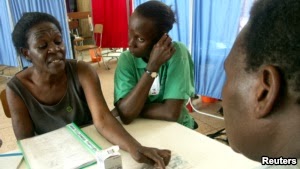Report Shows Big Drop in New HIV Infections

 A new report from UNAIDS indicates that the rate of new HIV infections
A new report from UNAIDS indicates that the rate of new HIV infections
has dropped significantly over the past decade. The report estimated
2.3 million adults and children were newly infected with HIV in 2012,
a figure that represents a 33 percent reduction in annual new cases
compared to 2001. The report says the most striking results in
combating HIV, the virus that causes AIDS, are to be found among
children, for which the number of new HIV infections has been cut by
52 percent since 2001. Mahesh Mahalingam is the Director of the Office
of the Deputy Executive Director of UNAIDS. He said a major element of
this progress is that many more pregnant women who are living with HIV
are receiving medication that prevents transmission of the disease
from mother to child. "Nearly 62 percent of women who are pregnant and
have HIV have received anti- retroviral medicine. As a result, the
number of children becoming infected with HIV has dropped to record
low levels from nearly half a million just about 10 years ago. Now
only about 260,000 children were infected with HIV. We hope that by
2015, we can bring this number down to virtually zero," said
Mahalingam. The report notes that some 9.7 million people in low and
middle-income countries were accessing antiretroviral therapy by the
end of 2012, an increase of nearly 20 percent in just one year. The
report's authors say this dramatic acceleration makes them optimistic
that the Millennium Development Goal of having 15 million people on
HIV treatment will be reached by the 2015 target date. In 2012, the
report found an estimated 35.3 million people globally were living
with HIV and 1.6 million had died from AIDS-related illnesses. Sub-
Saharan Africa remains the most heavily infected region in the world.
It says most new HIV infections have occurred in Sub-Saharan Africa,
while the continent as a whole accounts for nearly 75 percent of all
people living with HIV in the world. Mahalingam points out that
government leadership combined with community action is succeeding in
turning the epidemic around in some places. "The most amount of
progress is happening in the country that has the largest number of
people living with HIV in the world, and that is South Africa. In
South Africa, record numbers of people have been put on antiretroviral
therapy and… about 50 percent decline in new infections have occurred
in that country," he said. The study found rises in new HIV infections
in Eastern Europe, the Middle East and North Africa. It says Ukraine
is making progress in combating the disease, but elsewhere in Eastern
Europe drug-injecting users are fueling the epidemic. It says most new
HIV infections in developed, Western countries are occurring among gay
men. It says people in the United States and Europe view AIDS as a
chronic disease, one which can be treated with medication. As a
consequence, the report says many people are becoming complacent and
are no longer taking preventive measures. UNAIDS says punitive laws
that criminalize sexual behavior, in addition to stigma and
discrimination, prevent people from coming forward to learn their HIV
status and get treatment. It warns that this has the effect of driving
the disease underground and worsening the epidemic.




